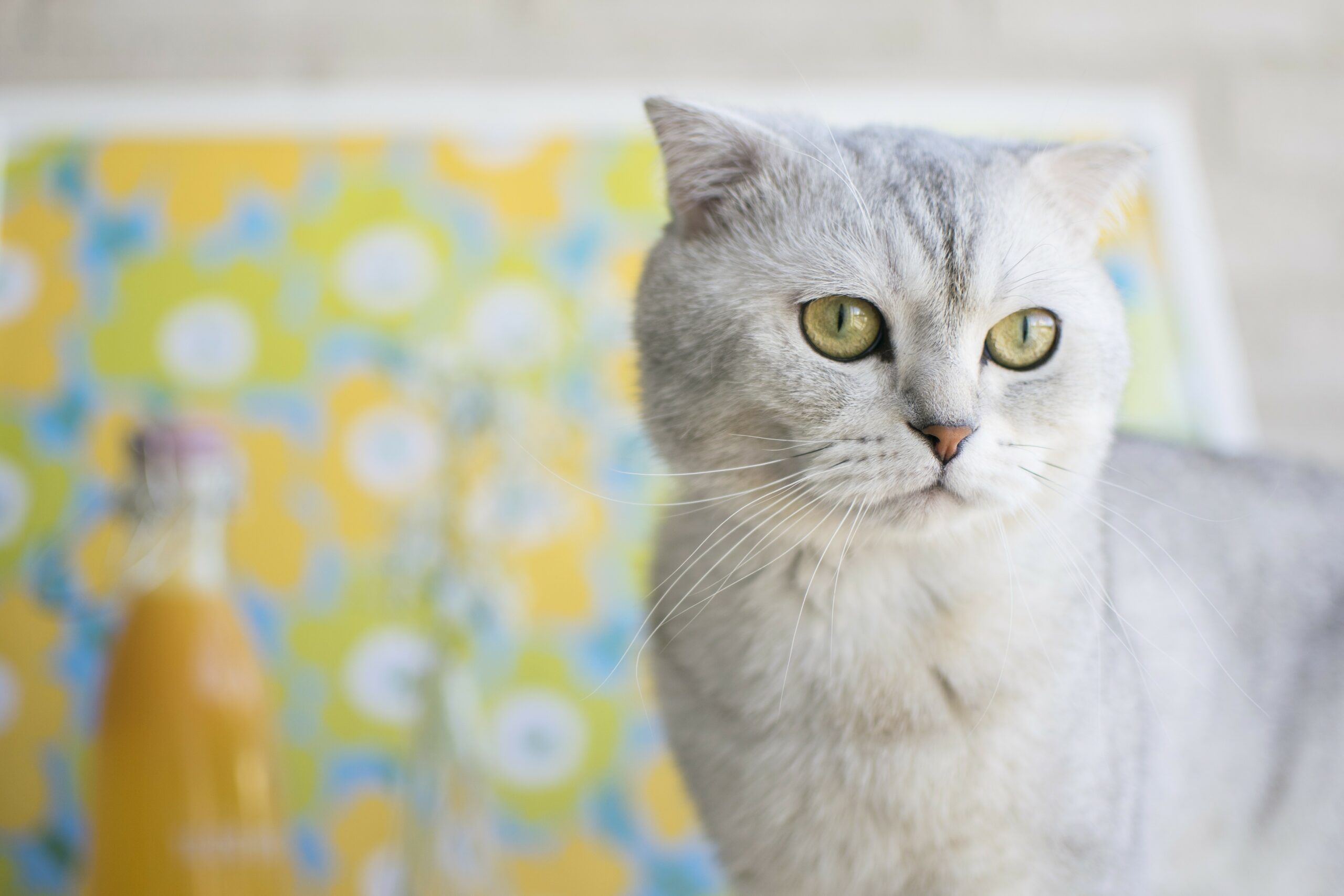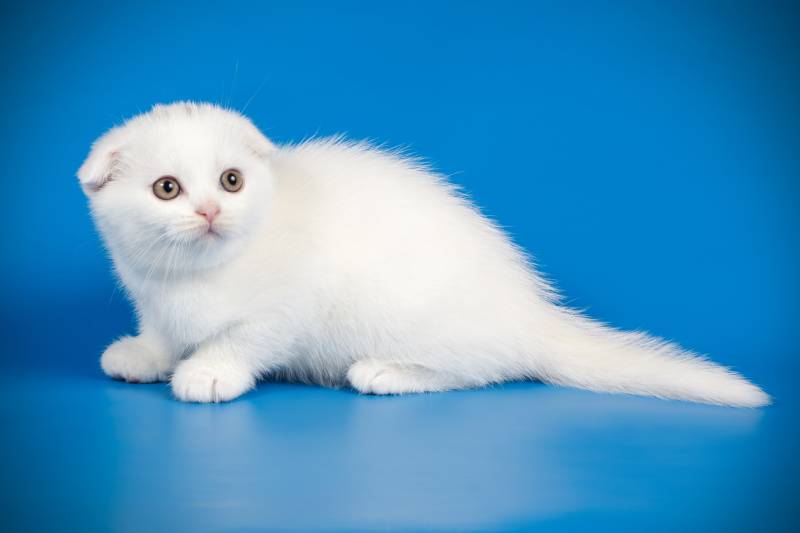
Click to Skip Ahead
There’s no cat quite like a Scottish Fold; you can spot those owlish features and big, round, earnest eyes from a mile away. If you’re a fan of Scottish Folds, you may be curious about the breed’s origins, where those famous folded ears came from, and other quirky Scottish Fold facts, so read on to sharpen your knowledge about these very endearing cats and their history.
Breed Overview
Height:
8–10 inches
Weight:
6–13 pounds
Lifespan:
14–16 years
Colors:
Pretty much any possible color, including white, blue, black, cream, red, lilac, chocolate, cinnamon, and fawn
Suitable for:
Any loving family that will handle the Scottish Fold gently and respectfully
Temperament:
Docile, quiet, sweet-natured, very people-oriented
Scottish Folds are incredibly versatile in terms of appearance since they come in such a wide variety of colors, color combinations, and patterns. In addition to common colors like white and black, the Scottish Fold also comes in various chinchilla, shaded, tabby, tortoiseshell, smoke, calico, and pointed combinations. Scottish Folds can be either shorthaired or longhaired.
Other distinguishing Scottish Fold features include folded ears (though not every Fold has this trait), big, round eyes, a rounded body head and body, and a short nose.
White Scottish Fold Characteristics
The Earliest Records of White Scottish Folds in History
As the name gives away, Scottish Folds hail from the land of lochs and towering peaks. In 1961, in Perthshire, Scotland, a British Shorthair breeder named William Ross noticed a very unique-looking cat on a neighbor’s farm. The cat, Susie, had a white coat and folded ears, though her mother didn’t share this trait and the owners never found out which cat fathered her.
Susie had recently given birth to a litter of kittens, and, with permission, Mr. Ross took one of the kittens (Snooks, also white) home and, thereafter, began to develop the Scottish Fold. The types of cats used in Ross’ breeding program were regular domestic cats from nearby farms and British Shorthairs. A geneticist, Pat Turner, aided Ross in his efforts.

How White Scottish Folds Gained Popularity
In the 1970s, Scottish Folds stopped being bred and registered in the UK due to various health concerns, including ear conditions like mites and deafness, and bone deformities.
However, the breed soon headed over to the US, where American breeders endeavored to improve breeding quality by bringing the American and British Shorthair into the mix. However, osteochondrodysplasia, which causes Scottish Folds to have folded ears, is still a welfare concern for this breed.
In the United States, the Scottish Fold quickly became popular with show judges and cat fanciers, who were endeared to these cats’ unique, owl-like features, plush coats, and gentle dispositions. In recent years, the Scottish Fold has been brought even more into the spotlight by celebrity owners like Taylor Swift and Ed Sheeran.
Formal Recognition of the White Scottish Fold
The Scottish Fold was originally allowed to be registered with the Governing Council of the Cat Fancy (GCCF) in the UK in 1971, but this recognition was quickly dashed when health and welfare concerns came to light. In the notes section of the GCCF’s list of non-recognized breeds, there is a comment which reads “Ineligible. Known serious health problems (osteochondrodysplasia).”
However, other associations do recognize the Scottish Fold. The Cat Fanciers’ Association (CFA) awarded Scottish Folds championship status in 1978, and the breed is also recognized by the American Cat Fancier’s Association (ACFA) and The International Cat Association (TICA). Various colors are accepted, including, of course, white.

 Top 3 Unique Facts About White Scottish Folds
Top 3 Unique Facts About White Scottish Folds
1. Not All Scottish Folds Have Folded Ears
When kittens are born, it’s not certain whether or not their ears will fold until week 3 or 4, because the ears remain straight like those of any other kitten until this point. Some kittens’ ears never fold.
2. Scottish Folds Have Some Unique Sitting Positions
One of the funniest and cutest Scottish Fold quirks is that many like to perch on their back legs to survey their environment, similar to how a Prairie Dog or otter would.
Some like to slump in a more relaxed fashion with their hind legs spread far apart and their forepaws resting on their bellies, giving the impression that they’ve just eaten their body weight in food or are simply so over everything.

3. The Fold Is Caused by a Genetic Mutation
A genetic mutation is what causes the ears to fold, and this mutation is spontaneous. Sadly, this gene is also responsible for the bone and cartilage abnormalities Scottish Folds suffer from, which has caused a lot of controversy in the cat breeding world. Some think Scottish Folds shouldn’t be bred at all.
 Does a White Scottish Fold Make a Good Pet?
Does a White Scottish Fold Make a Good Pet?
No matter the coat color, Scottish Folds are lovely companions thanks to their sweet, devoted, and sociable natures. However, it’s important to be aware of health conditions that affect this breed, like osteochondrodysplasia, which may cause discomfort and, worst case, a great deal of pain. Some cats with this condition even end up unable to walk.
This disease affects both homozygous (cats with two of the same genetic alleles) and heterozygous (cats with two different genetic alleles), especially homozygous cats. For this reason, reputable breeders would never breed two Scottish Folds.
In terms of general care, the Scottish Fold is pretty low-maintenance. They need to be brushed once or twice weekly, but more often if they’re longhaired. Check their nails regularly, too, and trim them if they’re looking too long. Frequent ear checks are also a good idea.
Scottish Folds are very adaptable cats that get along well with everyone in the family as long as they’re treated with kindness. They’re also happy in any clean home environment, big or small, as long as they’re sufficiently exercised, and all their needs are catered for.
Conclusion
So, the Scottish Fold is a relatively modern breed that quickly burrowed into the hearts of both professional cat fanciers and cat lovers everywhere in spite of the controversy that has surrounded them since their early years. However, the cute ears do come at a cost since bone and cartilage problems are some of the main concerns surrounding the health and welfare of these cats.
Related Reads:
- Scottish Fold Siamese Mix: Pictures, Care Guide, Temperament & Traits
- Ragdoll British Shorthair Mix: Pictures, Care Guide, Temperament & Traits
Featured Image Credit: Pexels






